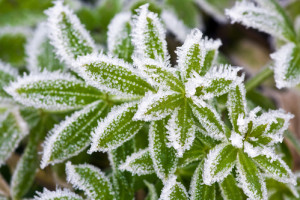Posts Tagged garden
Landscaping Guide: How to Create a Beautiful and Functional Garden Design
There is no perfect garden design for all properties. Therefore, if you are interested in improving your landscape by establishing a garden, you must create a custom design that matches your needs. We at DK Landscaping know that an ideal design should complement the unique aspects of your property. Each piece of land has idiosyncrasies which can be used in landscaping. In addition, you must think about your goals for your new garden. Here are some simple guidelines to help you get started.
Choose Your Plants Wisely
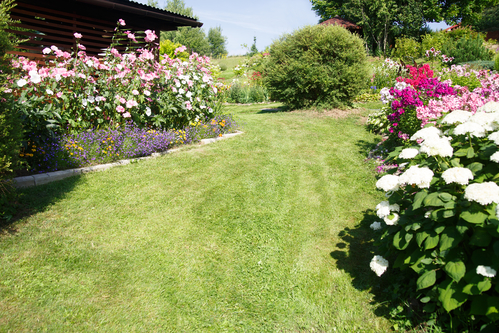
The best garden begins with the selection of the right plants to complement your landscape design and practical needs. In general, the first issue that you should consider when choosing your flora is the purpose of the garden. This space can be used to grow ornamental plants for aesthetic appeal. Alternatively, you can choose to grow edibles such as herbs and vegetables. If you are interested in both edibles and visual impact, it is possible to combine both types of plants.
The climate and environment is also an important consideration during the selection of plants for your garden. If you choose flowers, herbs or vegetables which cannot withstand growth in your local conditions, your garden will fail prematurely. It is advisable to choose indigenous plants because they grow naturally without the need for constant care. You can conduct research on the flora that grows in California for the best decisions.
Define the Boundaries
Boundaries are essential elements in garden design. If your garden does not have clear edges, your landscape will look like a wild land with plants growing haphazardly. Therefore, you must create distinct borders to define the perimeter of your garden and create order. If you would like to have a completely green landscape, consider using a hedge around your garden. For a more formal look, build a fence to isolate the space. It is also possible to edge the garden with stones. The stones will create a boundary without interfering with the visual effect of the garden.
Paths for Your Garden Design
Pathways are essential for a garden, especially one that experiences considerable foot traffic. The paths will allow smooth navigation around the space while protecting the landscape from the dangers of human carelessness. When designing your garden, you should think about the ideal places to form paths. You must also ensure that the path is wide enough for convenient use. To prevent the growth of plants on your pathways, consider installing a pavement or at least pouring gravel.
Borrow the Scenery
Gardens can be made more interesting by borrowing the scene from the surroundings. This borrowed scenery technique involves incorporating the view of a special feature into your garden. Simply speaking, this practice is about capturing the view beyond your own garden. For instance, you can trim the trees in your garden to reveal a distant building, your neighbor’s orchard or a mountain. Though these elements will not be on your property, they will have an impact on the aesthetics.
Enjoy Your Garden
Finally, you should create a comfort zone in your garden to allow you and your guests to enjoy the natural appeal of the space. For instance, a garden bench in a secluded spot might be perfect for settling and reading. A patio bordering the garden might be what you need for entertaining guests.
If you are interested in learning more about garden design, consult our landscaping experts for customized advice and guidance.
![]()
Finally…Here are the Elements of Amazing Garden Design!
Garden design is about getting the most out of your outdoor space and creating an inviting backdrop for family, friends, and neighbors.
You obviously want to get to the point of enjoying your outdoor landscape as soon as possible, but a lot of work goes in to getting things just right.
Garden design revolves around having the right location, soil conditions, boundaries, and surfaces to work around. That said, the elements of garden design can’t be overstated.
The Elements and Location of Your Garden

There are two basic elements of great garden design – something known as hard elements (i.e., relatively immovable design details like paths, walls, lounge chairs, and decks) and the actual plants and flowers that adorn your garden.
Hard landscape elements can include beautiful additions to your outdoor landscape like a koi pond stocked with fish or a stone path that gradually opens up to a breathtaking garden rich with flowers and color.
These two basic elements of garden design – the hard elements and the actual plants you use – dynamically work together to bring out the best in your garden.
Creating a Powerful Effect
The kind of paving that you use leading up to your garden can have a dramatic effect on the overall impact of your garden. Grey stone with purple lilac, for instance, can create a captivating French country look that really inspires.
On the other hand, working with a professional landscaping company to curate a manicured lawn and lush garden around black paving can create a modern look that’s both classy and inviting.
A professional landscaper can cut through all of the guesswork and help you determine what the best garden design for your home would be.
The best garden design for you is determined by your design preferences, of course, but also strongly suggested by your climate zone and any microclimates in your area.
Your particular climate can affect whether you’re able to plant annuals or whether hardier perennials would be a better choice. Your climate also impacts things like seeding, blooming, aeration, irrigation, and the soil foundation that fundamentally make a great garden.
The Soil, Boundaries, and Surfaces of Garden Design
A lot of homeowners want to fast forward ahead to enjoying a garden lush with roses, lilacs, tulips, and dahlias…and those are all beautiful. The foundation for all of those, though, is your garden’s soil.
There’s a process that a professional landscaping company can help you with known as amendment, which is where nutrients are added to your subsoil and topsoil to ensure that it provides a foundation for healthy plant and flower growth.
A landscaping company can use the right soil structure – whether that’s loam, silt, or some amount of clay – for your garden’s flowers, acidity levels, and your particular climate.
Boundaries and Surfaces for Framing
Having the right boundaries (e.g., a line of hedges and nice, white fence) and surfaces directly bordering your garden (e.g., woodchips, straw, or pebbles) can open up the possibilities with your garden design.
Using structural plants to frame the sides of your garden is a staple of good garden design as well. Boxwood and bay laurel can be planted year round and are relatively easy to maintain.
Evergreen shrubs are another popular border. The most popular border for most gardens is your lawn.
Having your lawn maintained or shaped and maintained around your new garden (lawns can be square, circle, or oblong-shaped) gets everything off on the right foot.
Professional landscapers can walk you through your options when it comes to garden design and picking the best aesthetic and practical features for your new garden. Contact us for more information.
Effective Gardening Tips Part 2 – Which Type of Irrigation is Best
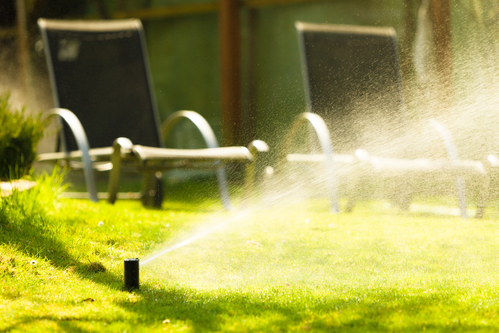 If you are a gardener, farmer or even a landscaper you understand the necessity of supplying your plants, gardens or crops with adequate water. Normally most gardeners use hoses or watering cans to water gardens but this is not always as effective because sometimes enough water might not penetrate the soil. In addition it might not be sufficient to supply what plants really require. An effective way to tackle issues such as this is to install an irrigation system which will properly supply gardens or crops with an adequate and timely supply of water.
If you are a gardener, farmer or even a landscaper you understand the necessity of supplying your plants, gardens or crops with adequate water. Normally most gardeners use hoses or watering cans to water gardens but this is not always as effective because sometimes enough water might not penetrate the soil. In addition it might not be sufficient to supply what plants really require. An effective way to tackle issues such as this is to install an irrigation system which will properly supply gardens or crops with an adequate and timely supply of water.
Different Types
The basic concept of an irrigation system mainly entails water being obtained from a source and distributed in specific amounts equally and uniformly to each plant or crop. Different kinds used include high or micro flow irrigation, sub-irrigation, in-ground irrigation, localized irrigation and even automatic irrigation systems.
The systems mentioned are all utilized to best suit their specific purpose however the two most commonly used are the high flow and low flow irrigation systems. The first system delivers water to plants with a high flow while the latter operates with a low flow or drip.
Use A System That Best Suits Your Garden
If you are a farmer cultivating crops on agricultural land then the high flowing system would be more appropriate. With this type high water levels are used to flood and control the amount of water in each distinct field. It is also regulated by a series of slopes that enables a runoff of excess water.
With the low flowing or drip irrigation system water is transported and distributed to plants through emitters, mini rotors, micro sprays or drip lines in a dripping fashion delivering water directly to roots. Seen as a very efficient method, low flow irrigation utilizes less water and significantly reduces evaporation and runoff.
Over time methods have improved to better manage the different types of gardening done today so depending on the type of gardening that you practice, installing the type that is appropriate is the best way to ensure that plants or crops receive the water that they require.
We’re Here To Help!
If you are interested in installing an irrigation system in your garden but you don’t know what to do leave it to us we can come and install it for you. Here at Dk Landscaping Inc. we aim to provide the highest quality landscape and gardening services to clients. Our services are very affordable and we work with clients to manage any type of gardening environment give us a call at 707 217-6508 or contact us via email.
Hardscape Ideas for Lawn Landscapes
In creating gorgeous landscape designs people tend to go above and beyond in seeking to create and achieve the look they want. There are a variety of techniques that can be used to not only enhance but to give an elegant finish to any landscape or outdoor space.
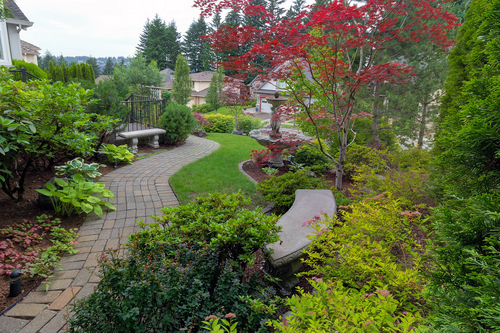
Bring Elegance To Your Landscape With These Hardscape Ideas
One very effective technique used to achieve the perfect finish to any landscape is Hardscaping. When speaking about hardscaping it refers to the structural inanimate features used and incorporated into a landscape to add a stylish and sophisticated appearance. These features can include anything from decks and walkways to edging and ornamental features and can be formal or informal depending on the style of your home and surroundings.
Nevertheless it is very important that varying textures be carefully considered as the texture of material/s used when hardscaping usually determines the final appearance of the landscape. Using too much or too little materials can result in a dull or cluttered finished look therefore to prevent any issues after the designed space is completed it would be best to choose no more than two or three textures of hardscape materials for projects.
Selected materials should be able to perfectly blend and complement the exterior structure of the home as well as be visually attractive. Other elements like color and drainage patterns once carefully and selectively used can and should improve the overall appearance of the home and surroundings.
Installing walkways and paths are also common elements incorporated within the hardscaping process and are used to accentuate and designate the areas in which traffic constantly travels. This is usually achieved by utilizing materials such as bricks, pavements, woodchips, flagstones, retaining walls, rocks or concrete blocks.
Different areas of the landscape may require various hardscape elements based on their purpose. For example using shredded tires painted in various colors for areas that children play or frequent. This provides a safe and attractive environment for kids who utilize outdoor surroundings for activities.
For areas used to entertain like dining or sitting areas the addition of a patio or deck accessorized with elegant furniture and decor are ideal ways to enhance and decorate big or empty areas. Water features like small ponds or fountains and ornamental accessories like a bird bath, statues or benches could also be great ideas that help to create a tranquil yet beautiful and characterized, outdoor space.
Once you have planned and designed the outdoor space that you wish to have the only thing left to do is to fill in your garden and lawn areas with the desired plants, trees or grass and proceed from there. Furthermore the addition of outdoor and garden lights will not only enhance and give ambiance to the outdoor area but provide a sense of safety and security when using outdoor spaces at night.
The concept of hardscaping really isn’t difficult to execute so long as planning is carefully and accurately done. It really gives an extra edge to outdoor spaces and surroundings while being an excellent expression of your unique taste and style. Contact us for more information.
Kinds and Uses of Fertilizer
Are you a gardening enthusiast or local farmer? Well if you are you most likely do all in your power to create and maintain a healthy environment for your blooms or crops. There are some cases though that crops or plants don’t grow to their full potential and one of the main reasons for this is poor soil quality. There are a few techniques that can be applied to rectify the issue of poor soil quality one of which is the use of fertilizer.

Fertilizers In Detail
Fertilizer can come in several forms and is an excellent way to enrich your soil and promote plant growth. Before using fertilizer with your plants or crops it would be a good idea to educate yourself on the different types of fertilizers and why they are used. It would also be best to read labels to ensure that applications are accurately made when using fertilizer. Here is a list of some of the most commonly used fertilizers in gardens or on farms. These include:
- Organic Fertilizer – These consist of naturally bio-degradable materials and mostly come in the form of animal manure but others can also contain compost, seaweed, peat moss, mineral deposits and other ingredients from nature. This type of fertilizer is great for gardens and crops as it not only restores the overall soil quality but improves the long term health of soil.
- Inorganic Fertilizer – Again this type of fertilizer can come in several forms including liquid, powdered or granular form. These fertilizers are generally used to treat industrial fields as they are cheaper and produced on a large scale. They also allow plants to carry nutrients from the soil easily since they are not as bulky as organic fertilizers.
- Chemical Nitrogenous Fertilizer – This type of fertilizer usually comes in granular form and has a high content of nitrogen. Once applied to the soil it is converted to ammonia and dissolves when it rains where the nutrients then travel through the ground and into the plant’s roots.
- Phosphate Fertilizer – This is mainly applied to soils that are acidic and is contained in both organic and synthetic forms. This type is usually applied during the sowing season.
- Potassium fertilizer – This is normally utilized to help improve plants thriving in sandy soil. It works to increase the potassium content where it’s inadequate. Potassium fertilizer can come in the form of sulfate of potash and muriate of potash. Sulfate of potash is made by treating potassium chloride with magnesium sulfate and muriate of potash uses a crystallized form of potash to fertilize plants which is absorbed at the surface level of the ground.
Now that persons are a bit more educated on the different types of fertilizers and their uses they should easily be able to determine how and what type of fertilizer they should use to achieve the best results with their plants or crops. Contact us for more information.
Winter Plants – Part 2
During the winter season creatures prefer to hibernate and wait until nature affords them the opportunity to venture out into warmer conditions. There are no different to us humans as we seek to make our homes warm and comfortable during the dreaded winter weather. Your garden is certainly apart of your home and you should do all in your power to ensure it can handle winter’s fury and look its best. Vibrantly colored winter plants or even winter vegetables can enhance the life of a damp gloomy landscape.
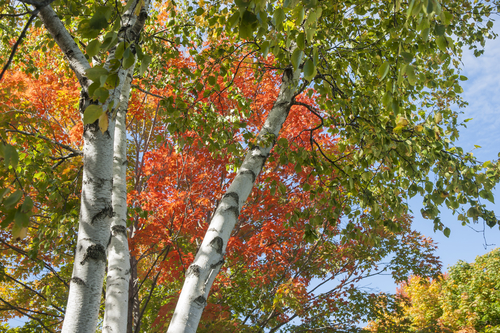
Know Your Winter Plants
An uncommon but very fascinating winter plant is Harry Lauder’s Walking Stick or Corkscrew Hazel. Even though, this shrub flowers in the spring season, it is a beautiful winter plant. This is due to its coiled and zigzagged branches. This plant tends to grow better in a fusion of bright sunlight and shade. The branches will need frequent trimming to preserve its attractive appearance however when they fall they can resemble an overgrown untidy mesh of wood.
The Paper Birch tree displays its gorgeous yellow leaves in autumn. However, when it gets extremely cold, its white bark provides a sensational difference to a backdrop of evergreens. Frequently they are used during the Christmas holidays in many gardens. The paper birch tree should be planted in deep holes with mulch to keep it damp. Partial sunlight will be essential for this plant.
The Heather plant is another suitable winter plant. It flourishes all year round and provides attractive flowers in summer and fall. It’s rich foliage provides a fascinating difference when compared to other winter plants. You should plant these in winter with mulch in an area that obtains excellent sunlight.
Holly has always been linked to winter and there are 400 assortments to select from ranging from small to gigantic trees up to 80 feet. There are various types of the holly plant to fit every garden and winter scenery. Its vibrant berries and dense foliage make it very eye-catching.
Hellebore is another winter plant that can be obtained in a fusion of selections. When flourishing it has a cup like shape and they come in an array of colors making it easy to find a color that best suits your winter garden. This plant flourishes better in total shade. Contact us for more information on how you can make create the perfect winter landscape.
Garden Design for Dry Shady Gardens
When you’re looking to improve the landscape around your home or business, dry areas with shade can be tricky when it comes to garden design. Luckily the modern practice of xeriscaping has provided many solutions that can be used to get a beautifully landscaped property even when planting in dry shade.
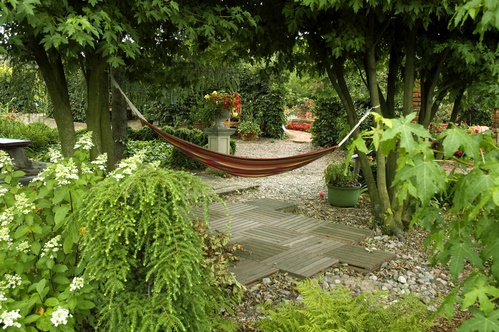
Basic Garden Design Principles
Any of the basics of good garden design apply to dry shady areas as well. You will want to think about how the area is going to be used, whether you prefer a casual or more formal style, and what your budget will be.
You will want to consider the size and shape of the plants and the visual lines they create. It can be helpful to start with the larger elements or focal points of your design, and then fill in the smaller details from there. Variety is necessary to create visual interest, but too many different colors, textures and plant species can create a chaotic look that lacks cohesive design. A common element such as a particular species of plant or a recurring color can help tie different areas together into an overall design.
For a successful dry shade garden design considering the water supply is vital. This is where consulting a landscape professional can be especially helpful. They will have ideas for making the best use of naturally available water. They may recommend grading an adjacent area to improve drainage, diverting extra water to a drier area. Including rain water harvesting in your garden design or changing irrigation methods may also be options.
The Importance of Plant Selection in Dry Shade Garden Design
One of the biggest decisions in garden design is choosing plants. You can get a garden design that is practical, unique and aesthetically pleasing, even in dry shade. It may limit your options a little more than having perfect growing conditions, but there are still plenty of plants to choose from. Skeptical? Check out this large list of plants for dry shade or this amazing list of native California drought tolerant plants. Many of these species grow just fine in shade. The growing popularity of xeriscaping means there are more plants available to homeowners and landscape professionals that tolerate dry conditions. Native plants will also grow better in dry shade since they are already adapted to local conditions.
One of the most useful garden design practices for dry shade is grouping together plants with similar water and nutrient requirements. Plants will not have to compete with each other to get what they need and will be more likely to thrive. Reducing the amount of turf lawn in a dry shady area or using grass varieties that require less water can also be helpful.
Soil Preparation is Key
When it comes time to make your new garden design a reality, soil preparation is especially important. The water and nutrient requirements of the new plants and condition of your existing soil will determine your exact course of action. In general, adding organic matter such as compost may be necessary. This will help your dry soil retain water and increase the nutrients available so your plants can thrive. Mulch also serves the same purpose and additionally deters weeds. Using these together will give your new plants the best chance to establish a good root system and promote growth.
While there are lot of things to consider in good garden design, the effort can save property owners money in the long run by reducing fertilizers, water, and maintenance. Get help with your landscape design and maintenance needs. Contact us today!
7 Gorgeous Flowering Shrubs for Shade
A shady yard doesn’t have to stop you from having a gorgeous, lively landscape. Flowering shrubs that thrive without direct sun are a perfect choice for jazzing up your landscape, and there are many varieties to choose from. Here are our top 7 choices for flowering shrubs that work well in Zone 9:
Oakleaf Hydrangea (Hydrangea quercifolia species)
With its spikes of beautiful white flowers and distinctive oak tree-shaped leaves, this shrub attains an impressive height and width of six to 10 feet and is partial to moderate shade. In late summer, its blooms change to a pinkish purple, and come fall, the leaves take center stage and put on an impressive show of orange-red, purple and brown, which lasts well into winter.
Rhododendron (Rhododendron species)
A shrub with its own fan club, there are more than 900 species of the Rhododendron. Most grow to a height and width of eight to 10 feet, bloom in late spring, and then present attractive foliage after that. This is the shrub to choose if you’re looking for colorful shade flowers – and with all the different varieties on the market you’ll have no problem finding your favorite color.
Serviceberry (Amelanchier species)
Another shrub with multiple varieties to choose from, you’re sure to find one that meets your yard’s aesthetic needs. The company running serviceberry is a compact four to six-foot shrub that’s perfect for smaller landscape layouts. A year-round winner, blooms debut in the spring and edible berries make a June appearance. Those who love low maintenance shrubs will love that it requires little pruning.

Japanese Kerria (Kerria Japonica species)
Slow to start but followed by rapid growth, this three to six-foot shrub is the one to choose for year-round color. Bright green leaves that appear in summer last through most of the fall, when attractive yellowish green or bright green stems appear to brighten up your winter landscape. Gorgeous, bright yellow blooms make a spring appearance.
Virginia Sweetspire (Itea Virginica species)
With vivid red leaves that last well into the fall, these four to five-foot shrubs burst with fragrant summer flowers and are extremely resistant to disease or insect problems. The Little Henry is a popular choice that gives better-known shrubs such as the burning bush a run for their money.
Red Chokeberry (Aronia Arbutifolia species)
Stunning crimson leaves in the fall and bountiful red berries that brighten up even the drabbest of winters, these shrubs grow from six to 10 feet high. The red chokeberry is a resilient shrub that does well even in poor soil, and it tolerates both wet and dry conditions. Glossy summer foliage complements the small white or red-tinged blooms that make their appearance in the spring.
Sweetshrub (Calycanthus floridus)
A versatile classic, this moderate-shade shrub continues to gain popularity due to its xeriscaping properties. It works well in dry to damp soil and grows from four to six feet tall. The sweetshrub’s maroon flowers bloom from spring to summer and are often highly fragrant; the leaves on these shrubs have a coarse texture. If you have a yard that sees frequent visits from deer, this is the shrub for you.
Finding just the right shrubs to plant in the shady areas of your landscape may seem like a challenge, but as these selections show, there are plenty of varieties to choose from. Whether you choose one particular species as a show-stopping focal point or mix and match several kinds, these recommended shrubs should bring some beautiful color and life to even the most sun-deprived areas of your yard. Contact us for consultation on your gardening project.
Flower Bed Ideas – A Few Good Tips You Should Follow
Flower beds are one of the most convenient ways of sprucing up your outdoor decor and beautifying your entire yard.
Planting a flower bed is also a labor of love for millions of homeowners who already have the knack (and experience) for it; for those who don’t, the rest of this post if for you.
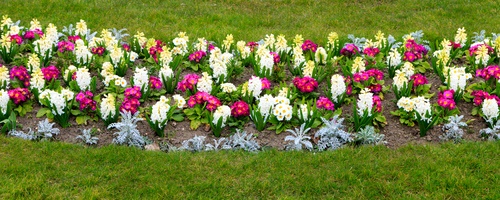
And if you’re still worried about your garden or you feel like your entire yard could benefit from aeration, then don’t hesitate to contact us your lawn experts. Now, let’s get started:
Tips for the Perfect Flower Bed
The perfect flower bed brings together form and function by applying a few simple tips in order to create a whole that’s greater than the sum of its parts.
- Focus on Framing
Part of the “form” part of creating the ideal flower bed for your home is going with a melange of perennials, annuals and shrubs for variety and framing.
In the same way that what’s in the background on a stage set can help to frame all the action going on in the foreground, you want a “framing device” in the back of your flower bed to draw your eye into the action.
A good rule of thumb is to plant tall perennial plants in the back of your garden to get the most out of everything going on upfront.
If you’re on a tight budget or you want to make a simpler landscaping project for yourself, then you can always put shrubs behind your perennials and annuals as well.
- Blend Perennials and Annuals
Annual flowers cycle through the germination, seeding, flowering and expiration process in one single year whereas perennials are able to grow from one year to the next with an off-season of dormancy in the winter.
The good news is that perennials like roses, daylilies, and peonies tend to play nice with annual flowers like marigolds and zinnias when it comes to finding the right balance between earth tones and more vibrant colors for your home garden.
- Combining Earth Tones and Vibrancy
In particular, the pink of a blossoming peony tends to work beautifully with the vibrant red of most roses. Marigolds and zinnias can also work well together if you’re looking to combine more tropical orange and yellow tones into your next flower bed.
Zinnias are actually easier to cultivate than most annuals and come in a myriad of colors that can make any garden really pop and dazzle guests.
You can find zinnias in purple, crimson, rose and scarlet to suit your tastes and make a flowing color combination with actual roses or even peonies when it comes time to get going.
Putting on the Finishing Touches
Once you know the kind of look that you’re going for and how to frame it with shrubs and/or tall perennials, then you want to move onto decorating fences or surrounding wall structures.
For this the beautiful pink and purples of an annual flower like the climbing snapdragon or greens, purples and yellows of passion flower can work very well.
Peony and roses upfront with climbing snapdragon or passion flower snaking along overhanging structures are an awesome want to frame your garden as well as beautify your home and complement your other landscaping efforts.
For help with aeration, irrigation, gardening or regular landscaping maintenance, or just to find out more tips like these, get in touch with DK Landscaping today.
Practical Winter Gardening Advice For Homeowners
Are you looking to get the most out of your garden year-round? The good news is that a lot of common shrubs, plants and flowers do well against frost in more intolerant hardiness zones.
So, what is a hardiness zone and how does it affect your winter gardening? A hardiness zone is a map put out by the USDA that basically tells gardeners which plants work best in which climates.
General Winter Gardening Tips
What’s important to realize upfront is that plants that can withstand the frost usually enter a period of relative dormancy to survive the winter months.
So, what are some things that you can do to make this transition easier on your hardy plants and perennials?
- Remove Waste
Removing any refuse, blackened-out stems and leaves from annual flowers is a great way to lessen the possibility of pathogens in the soil harming your hardy plants during their dormancy period.
- Install a Cold Frame
A cold frame (more on this below) is a raised wooden structure with a plastic cover that can further help protect perennials and hardy bulbs against the elements.
Even when plants are considered perennial, they still might benefit from the protection that a cold frame offers – especially if the temperatures drop to below zero with the wind chill.
- Apply Winter Mulch
On the topic of mulching, you should also realize that a lot of your summer mulch may have already decomposed at the start of winter.
Laying down a fresh layer of winter mulch goes a long way towards protecting your hardy plants and underlying soil during winter.
http://gardening.about.com/od/winterinthegarden/a/WInter_Mulch.htm
You can actually work with the elements by turning the fall’s fallen leaves into a winter mulch that will stay frozen and protect your garden.
Winter Gardening Devices to Consider
In addition to paying attention to your hardiness zone, devices like a quick-hoop system, floating row cover, or cold frame can greater buffer those punishing winter winds and cold temperatures.
- Quick-hoop system
Quick-hoop systems are also called low tunnel systems, and by whatever name these structures have been known to protect your plants from winter’s frost.
Annual and perennial hardy plants are able to survive the rigors of winter, frost and heavy winds. This means that calendula, foxglove, pansies and peonies require little maintenance during winter beyond the protection from a low tunnel system.
Hardy plants like these require less light to develop fully and can withstand hard frosts. Hardier plants only require around four hours of sunshine every day and grow best in cooler conditions.
If you’re living in an area that gets less frost, then many of these plants can be grown throughout the winter months. It’s recommended, though, that you plant hardy plants when the soil temperature is around 40 degrees fahrenheit – perhaps in very late winter or very early spring.
Low tunnels provide more protection against cold temperatures, frigid winter winds, and more relative humidity than the surrounding environment.
http://www.motherearthnews.com/organic-gardening/low-tunnels-quick-hoops-zmaz09onzraw.aspx
- Floating Row Cover
Floating row covers are probably the most simple and straightforward form of winter protection.
Putting your hardy plants under a thin film can protect against cold, harsh winds and potential hail damage while allowing an extended growing season for hardy plants and perennials.
- Cold Frame
The most popular kind of cold frame is a portable cold frame encased in wood with a durable plastic cover to protect against the elements.
That said, there are three types of cold frames (pictured here) that can extend your growing season well past frost. For more winter gardening tips, contact the professionals at Xeriscape today.


